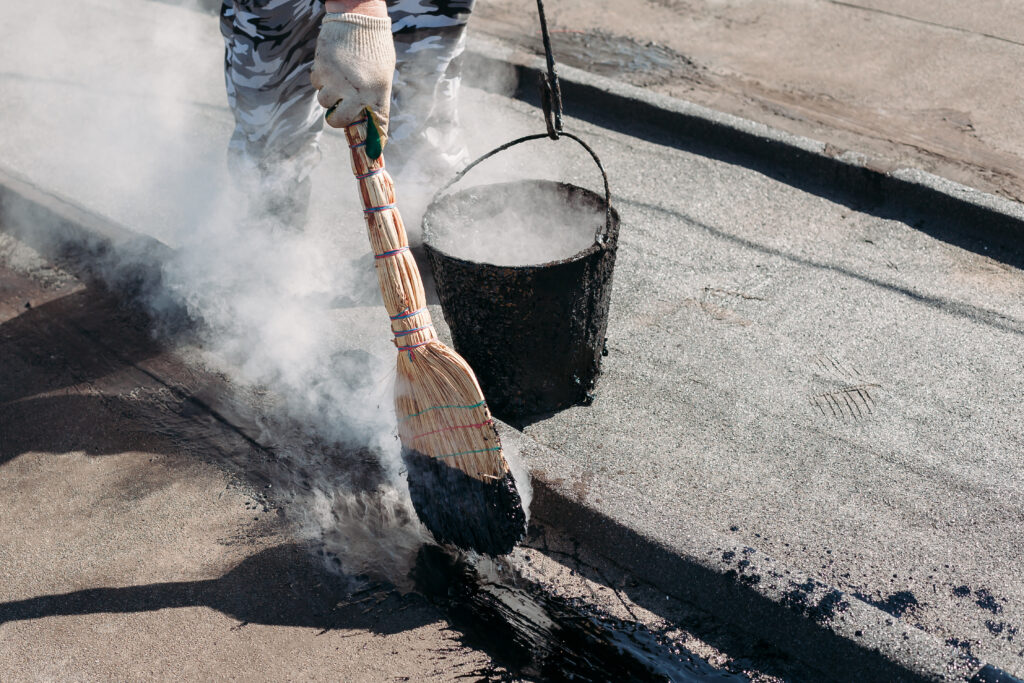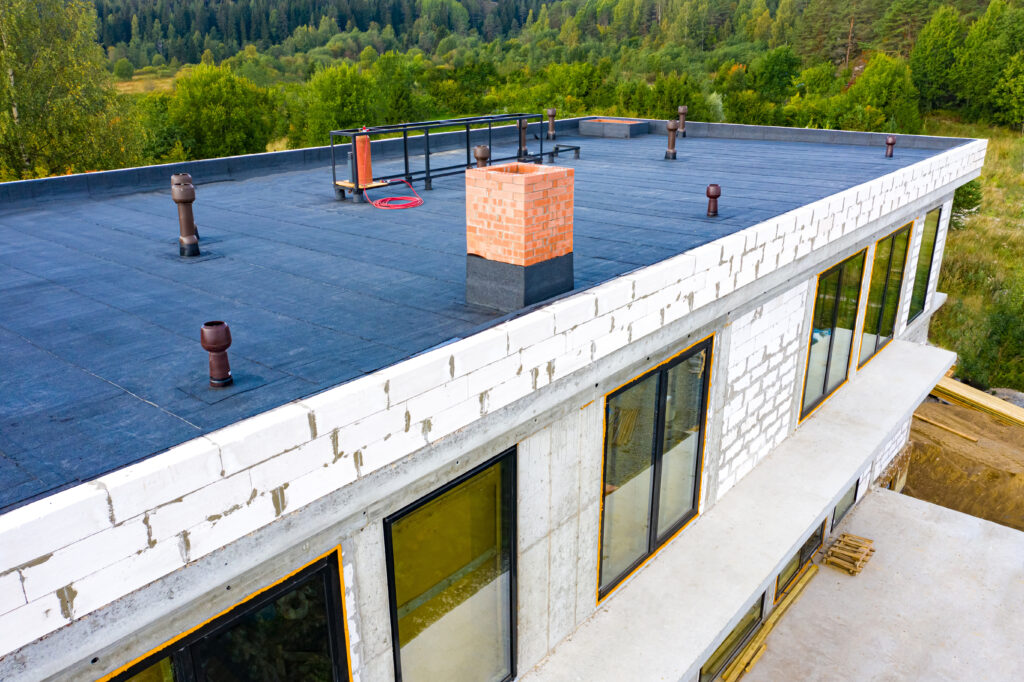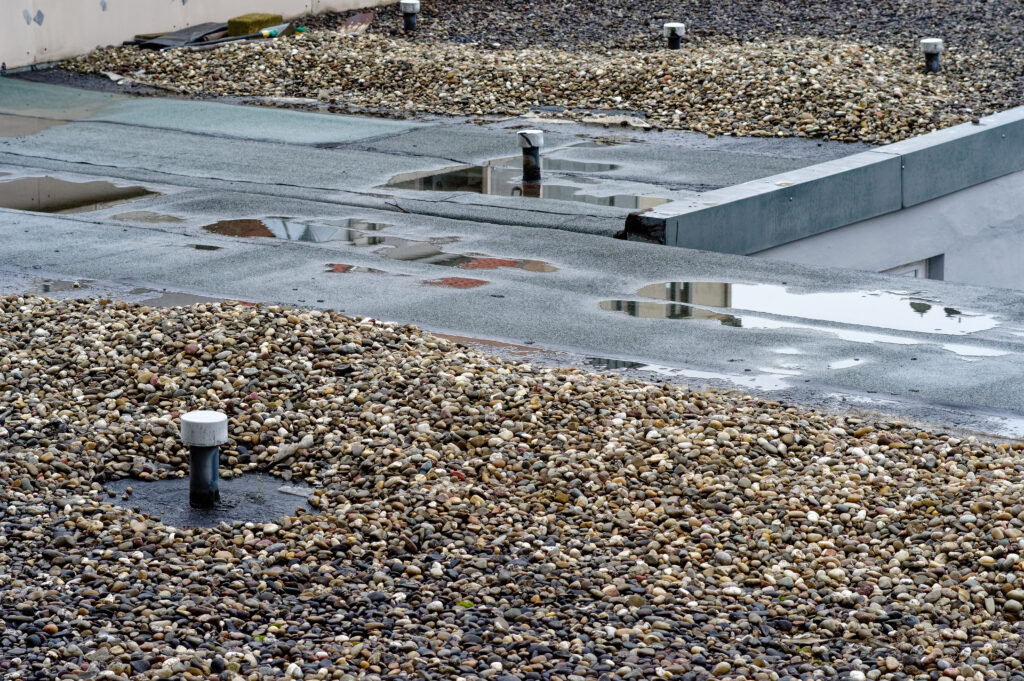Choosing a roofing material goes beyond aesthetics or budget; it’s about safety and longevity. Once you start looking into that, you’re sure to come across tar and gravel roofs.
Most people expect to see tar and gravel roofs on commercial properties, but they can also be a great fit for residential buildings.
Scroll down to see what tar roofing is, what to keep in mind when considering this affordable roofing material, its pros and cons, and the best alternatives.
What Is a Tar Roof?
A tar roof, aka built-up roofing system (BUR), is a roofing system that consists of layered tar and fabric, sometimes with embedded gravel.
Tar and gravel roofing systems consist of:
- Insulation: This is often really important with tar since it can get really hot in the summer, depending on your area’s climate.
- Base Sheet: This is what you apply the tar on, and it can be attached to your roof with chemical adhesion or mechanically.
- BUR Layers: Hot tar layers are then laid on the base sheet along with reinforcing fabric. It’s often recommended to get 2-4 layers for optimal protection, although this will affect the total weight. Some buildings may not handle that much.
- Surface Layer: Finally, a layer of gravel (and some other materials) is laid on top of the wet tar, adhering to it and protecting it from the elements.
Pros and Cons of Tar and Gravel Roofs

Tar and gravel roofs make a tough, protective barrier for your roof surface. They’re a tried-and-tested flat roofing system that’s been around for a century.
That said, the system doesn’t work for all buildings and climates.
So, let’s look into the pros and cons of installing a tar and gravel roofing system.
Pros:
- Durability: With proper installation and maintenance, tar roofs can last between 20-30 years.
- Cost-Effective: This is one of the cheapest roofing systems in terms of initial cost. It can also have low maintenance costs if you diligently take care of it.
- Weather and Shock Resistance: Aside from protection against weather conditions like rain, snow, and hail, this system handles impact from things like falling branches very well.
Cons:
- Weight: Because of their layers and gravel, tar roofs can be quite heavy. This means that a modern, structurally sound building is essential.
- Heat Retention: The black tar has a propensity to retain heat. This can translate to warmer building interiors and higher air conditioning energy costs.
- Aesthetic Limitations: Tar and gravel roofs lack the variety of design and color options available with materials like shingles or tiles.
- Installation Process: Installing a tar and gravel roof isn’t a DIY-friendly task. The process involves handling melting tar, which is dangerous and produces toxic fumes, so professionals are needed. Additionally, this method poses a fire risk if not handled with utmost care.
- Maintenance Challenges: Although tar roofs are durable, they require vigilant maintenance. Often, to locate roof leaks, large sections of the roofing might need to be stripped away, which makes roof repair tricky and expensive.
When to Choose Tar Roofing

Before you decide, it’s imperative to verify if tar roofing aligns with your building’s needs and characteristics. Here’s a checklist to consider:
- Structural Capacity: Ensure that the building can structurally support the added weight of a tar and gravel roof.
- Roof Slope: Tar roofing is ideal for low-sloped or flat roofs. If your roof has a steep incline, other roofing materials might be more suitable.
- Climate: In areas with extreme heat, roofing tar can retain more warmth, affecting indoor temperatures. It can even melt or weaken with major heat waves. Ideally, tar roofs are great for areas with a mild climate.
- Maintenance Commitment: Are you or your roofing contractor prepared for the routine checks and repairs? This roofing system demands regular upkeep to ensure its longevity.
- Budget: While it’s relatively cheap to install, regular maintenance and high air conditioning costs can add up over time.
Tar and Gravel Roofing Alternatives

If this build-up system doesn’t seem like a good fit for your property, there are plenty of other options to consider. Here’s an overview of the top alternatives for a slightly sloped to flat roof.
Modified Bitumen Roofs
Modified bitumen, which is the successor of conventional tar roofing, uses sheets of typical roofing asphalt that have been strengthened with plastic or rubber.
This results in a roof with greater flexibility, which is particularly useful in areas with significant temperature changes.
With two primary types, SBS and APP, this roofing system is an excellent choice for structures with moderate slopes that require a balance between durability and adaptability without stretching the budget too thin.
Ballast Roofing System
Utilizing a single-ply membrane, the ballasted system relies on large loose gravel to keep the roofing materials in place.
The weight of the ballast not only secures the membrane but also provides additional protection against UV rays.
This system is particularly useful for buildings with flat roofs that need a quick installation process without the use of harmful chemical adhesives. That said, it’s one of the heaviest types of roofing and needs a sturdy structure.
Single-Ply Roofing System
This streamlined, minimalistic approach consists of just one layer. Variations include EPDM, a rubber-like robust material, TPO, known for its heat-reflective properties, and PVC, which is durable and fire-resistant.
This system offers protection against rain, light snow, and heat. Some types offer protection against hail and other debris falling on your roof, but for the most part, it’s not a good choice for that kind of protection.
It’s ideal for properties with a slightly sloped or flat roof that require a really lightweight, mostly DIY-friendly roofing system.
Asphalt-Based Roofing
This roofing system uses rolls of material that are similar to giant shingles, made of saturated organic felt or fiberglass matting and coated with asphalt for waterproofing.
While it’s a simpler and often more affordable option, it may not have the longevity of some other systems. It’s a good fit for outbuildings, sheds, or structures where budget considerations are primary.
Final Thoughts
A tar and gravel roof may be perfect for your property, but you can’t really know that without consulting a professional.
At Paramount Exteriors, we’ve garnered loads of experience serving homeowners of South Dakota. We know how these storms can do a number on your home, and we can help you weather each and every one of them!
Reach out now and get a free, no-obligation inspection!
